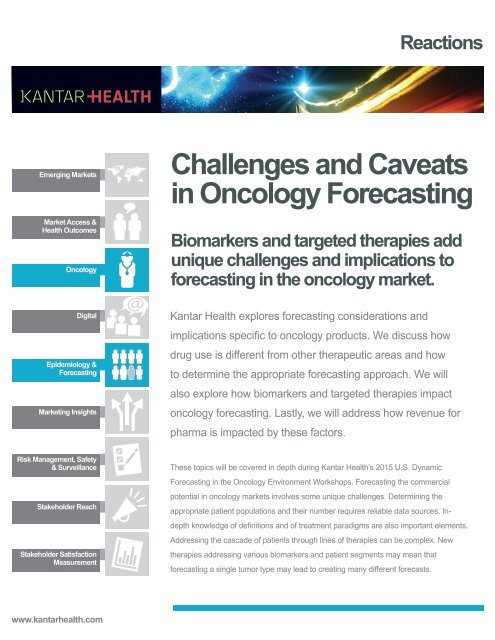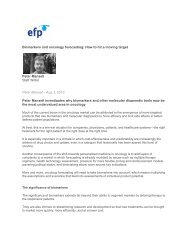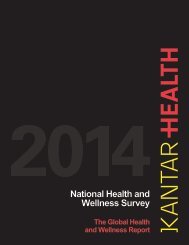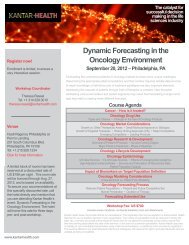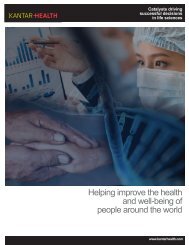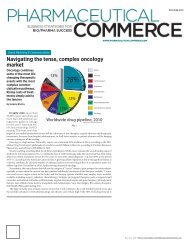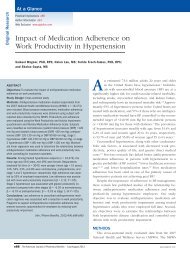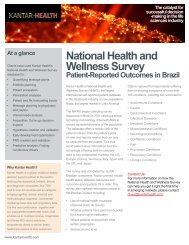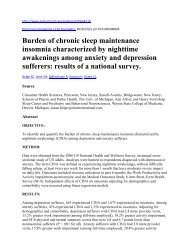Challenges and Caveats in Oncology Forecasting - Kantar Health
Challenges and Caveats in Oncology Forecasting - Kantar Health
Challenges and Caveats in Oncology Forecasting - Kantar Health
You also want an ePaper? Increase the reach of your titles
YUMPU automatically turns print PDFs into web optimized ePapers that Google loves.
Reactions<br />
Emerg<strong>in</strong>g Markets<br />
Market Access &<br />
<strong>Health</strong> Outcomes<br />
<strong>Oncology</strong><br />
Digital<br />
Epidemiology &<br />
Forecast<strong>in</strong>g<br />
Market<strong>in</strong>g Insights<br />
<strong>Challenges</strong> <strong>and</strong> <strong>Caveats</strong><br />
<strong>in</strong> <strong>Oncology</strong> Forecast<strong>in</strong>g<br />
Biomarkers <strong>and</strong> targeted therapies add<br />
unique challenges <strong>and</strong> implications to<br />
forecast<strong>in</strong>g <strong>in</strong> the oncology market.<br />
<strong>Kantar</strong> <strong>Health</strong> explores forecast<strong>in</strong>g considerations <strong>and</strong><br />
implications specific to oncology products. We discuss how<br />
drug use is different from other therapeutic areas <strong>and</strong> how<br />
to determ<strong>in</strong>e the appropriate forecast<strong>in</strong>g approach. We will<br />
also explore how biomarkers <strong>and</strong> targeted therapies impact<br />
oncology forecast<strong>in</strong>g. Lastly, we will address how revenue for<br />
pharma is impacted by these factors.<br />
Risk Management, Safety<br />
& Surveillance<br />
Stakeholder Reach<br />
Stakeholder Satisfaction<br />
Measurement<br />
These topics will be covered <strong>in</strong> depth dur<strong>in</strong>g <strong>Kantar</strong> <strong>Health</strong>’s 2015 U.S. Dynamic<br />
Forecast<strong>in</strong>g <strong>in</strong> the <strong>Oncology</strong> Environment Workshops. Forecast<strong>in</strong>g the commercial<br />
potential <strong>in</strong> oncology markets <strong>in</strong>volves some unique challenges. Determ<strong>in</strong><strong>in</strong>g the<br />
appropriate patient populations <strong>and</strong> their number requires reliable data sources. Indepth<br />
knowledge of def<strong>in</strong>itions <strong>and</strong> of treatment paradigms are also important elements.<br />
Address<strong>in</strong>g the cascade of patients through l<strong>in</strong>es of therapies can be complex. New<br />
therapies address<strong>in</strong>g various biomarkers <strong>and</strong> patient segments may mean that<br />
forecast<strong>in</strong>g a s<strong>in</strong>gle tumor type may lead to creat<strong>in</strong>g many different forecasts.<br />
www.kantarhealth.com
Reactions<br />
About the Expert<br />
Bob Ramsey<br />
Chief Scientific Officer<br />
Robert Ramsey, Ph.D., is Vice President <strong>and</strong><br />
Chief Scientific Officer at <strong>Kantar</strong> <strong>Health</strong>. Dr.<br />
Ramsey’s career spans over 30 years <strong>in</strong><br />
academia, product management, market<strong>in</strong>g,<br />
bus<strong>in</strong>ess development, <strong>and</strong> strategic plann<strong>in</strong>g.<br />
Dr. Ramsey has completed numerous projects<br />
for major pharmaceutical <strong>and</strong> biotechnology<br />
companies <strong>in</strong> all therapeutic areas, <strong>in</strong>clud<strong>in</strong>g<br />
cardiovascular, CNS, anti-<strong>in</strong>fective, <strong>and</strong><br />
oncology. Dr. Ramsey earned a Ph.D. <strong>in</strong><br />
Biochemistry <strong>and</strong> an M.B.A. <strong>in</strong> International<br />
Bus<strong>in</strong>ess from Sa<strong>in</strong>t Louis University, <strong>and</strong> he<br />
has postdoctoral tra<strong>in</strong><strong>in</strong>g <strong>in</strong> Neuroscience at<br />
the University of London, Engl<strong>and</strong>. In addition,<br />
Dr. Ramsey serves on the Institutional Review<br />
Boards of Wash<strong>in</strong>gton University Medical Center<br />
<strong>and</strong> St. Louis University Medical Center.<br />
Question 1: How does oncology drug<br />
use differ from other therapeutic<br />
areas? What factors must be taken<br />
<strong>in</strong>to consideration when choos<strong>in</strong>g<br />
between different forecast<strong>in</strong>g<br />
approaches?<br />
Drug use <strong>in</strong> oncology varies greatly from most<br />
other therapeutic areas <strong>and</strong> often <strong>in</strong>volves<br />
more drug regimens rather than s<strong>in</strong>gle agents.<br />
While drugs for the majority of therapy areas<br />
strictly treat the respective diseases <strong>and</strong><br />
alleviate symptoms, oncology drugs are high<br />
<strong>in</strong> toxicity due to damage to healthy cells while<br />
they work to battle exist<strong>in</strong>g cancer cells.<br />
Cancer drugs primarily are used for patients<br />
with active <strong>and</strong> late stage disease when other<br />
treatments like surgery <strong>and</strong> radiation will no<br />
longer improve outcomes, though cancer<br />
drugs can be used <strong>in</strong> the adjuvant sett<strong>in</strong>g<br />
after surgery when patients are cancer-free<br />
<strong>in</strong> order to improve the chances of survival.<br />
Comb<strong>in</strong>ation therapies add to the complexity of<br />
oncology drug use. In most tumor types, drugs<br />
are used <strong>in</strong> comb<strong>in</strong>ation <strong>and</strong> may not be part of<br />
a label claim which contributes to off-label drug<br />
usage.<br />
Patient-flow <strong>and</strong> cross-sectional forecast<strong>in</strong>g<br />
approaches are utilized depend<strong>in</strong>g on the<br />
circumstances <strong>in</strong> which the drug is utilized.<br />
The patient-flow approach is frequently used<br />
when there is concern about reuse of the same<br />
drug <strong>in</strong> the same patient. Patient-flow models<br />
are more complex, with patients be<strong>in</strong>g tracked<br />
from diagnosis, through the various stages of<br />
Figure 1: Uncover the opportunity for the breast cancer market<br />
through patient flow analysis<br />
75%<br />
62%<br />
17,000<br />
Adjuvant<br />
25%<br />
182,000<br />
25%<br />
27,500<br />
Breast Cancer patients<br />
present<strong>in</strong>g for drug<br />
therapy – US 2012<br />
38%<br />
Stage IV<br />
(new <strong>and</strong> recurrent)<br />
75%<br />
Incidence Stage HER2+<br />
C<strong>and</strong>idates for<br />
Hercept<strong>in</strong><br />
New Hercept<strong>in</strong><br />
Users<br />
Source: <strong>Kantar</strong> <strong>Health</strong> CancerMPact ® Patient Metrics<br />
www.kantarhealth.com
Reactions<br />
Correct <strong>in</strong>clusion <strong>and</strong><br />
application of biomarkers<br />
yields a commercial<br />
advantage.<br />
disease, patterns of recurrence, remission,<br />
<strong>and</strong> survival. A major concern is that, once a<br />
patient is treated with a given therapy, they are<br />
not eligible to be treated with the same therapy<br />
aga<strong>in</strong>. In this case, a patient-flow model is<br />
suggested, to avoid count<strong>in</strong>g <strong>in</strong>eligible patients<br />
<strong>in</strong>accurately.<br />
A patient-flow model is also best for diseases<br />
whose progression, survival, <strong>and</strong> treatment<br />
duration is expected to change over time.<br />
It is important to take these factors <strong>in</strong>to<br />
consideration when decid<strong>in</strong>g on a forecast<strong>in</strong>g<br />
approach, <strong>and</strong> to evaluate if additional <strong>in</strong>sight<br />
gleaned from a patient-flow model is worth the<br />
additional time, effort <strong>and</strong> resources, as is often<br />
the case with oncology forecasts. A crosssectional<br />
approach may be possible if one is<br />
focus<strong>in</strong>g on a s<strong>in</strong>gle population/<strong>in</strong>dication.<br />
Question 2: What unique forecast<strong>in</strong>g<br />
considerations are posed by<br />
biomarkers <strong>in</strong> oncology products?<br />
A biomarker is a characteristic that is objectively<br />
measured <strong>and</strong> evaluated as an <strong>in</strong>dicator<br />
of normal biological processes, pathogenic<br />
processes, or pharmacologic responses to a<br />
therapeutic <strong>in</strong>tervention. Currently, biomarkers<br />
are measured <strong>in</strong> one of two ways: on a<br />
cont<strong>in</strong>uum or yield<strong>in</strong>g a “yes” or “no” response.<br />
Biomarkers are becom<strong>in</strong>g more prevalent <strong>in</strong> the<br />
oncology market, <strong>and</strong> can have significant impact<br />
on drug development <strong>and</strong> oncology product<br />
revenue. Many biomarkers have become part<br />
of the st<strong>and</strong>ard of care, <strong>in</strong>clud<strong>in</strong>g therapies for<br />
breast cancer, colon cancer, chronic myeloid<br />
leukemia (CML), non-small cell lung cancer<br />
(NSCLC), melanoma <strong>and</strong> other tumor types.<br />
Biomarkers add complexity to oncology<br />
forecast<strong>in</strong>g s<strong>in</strong>ce populations must be precisely<br />
def<strong>in</strong>ed. In turn, assumptions are derived for<br />
each def<strong>in</strong>ed population, guid<strong>in</strong>g <strong>in</strong>formed<br />
decision mak<strong>in</strong>g to uncover commerciallyviable<br />
opportunities. It is important to consider<br />
that biomarkers may not always correlate <strong>in</strong><br />
conjunction with the cl<strong>in</strong>ical outcome.<br />
Accurate application is also very important. When<br />
applied <strong>in</strong>correctly, eligible patients who could<br />
benefit may be excluded. While many perceive<br />
the benefits of biomarkers to outweigh the<br />
negatives, they may not be necessary <strong>in</strong> all cases<br />
– many drugs have been developed without the<br />
use of companion biomarkers.<br />
Question 3: How do targeted<br />
therapies affect oncology<br />
forecast<strong>in</strong>g?<br />
Treatment methods for oncology vary based<br />
on the tumor type. One approach grow<strong>in</strong>g<br />
<strong>in</strong> popularity is the use of targeted therapies<br />
whether or not there is a correspond<strong>in</strong>g<br />
biomarker. Specifically, small molecule tyros<strong>in</strong>e<br />
k<strong>in</strong>ase <strong>in</strong>hibitors <strong>and</strong> monoclonal antibodies<br />
can be used as s<strong>in</strong>gle agents or <strong>in</strong> comb<strong>in</strong>ation<br />
with cytotoxic drugs or other targeted therapies.<br />
Although they represent the largest area of<br />
commercial growth <strong>and</strong> number of approvals <strong>in</strong><br />
the oncology market, there is still an unmet need<br />
for targeted therapies <strong>in</strong> efforts to reduce drug<br />
toxicity.<br />
Identify<strong>in</strong>g forecast<strong>in</strong>g assumptions is key <strong>in</strong><br />
assess<strong>in</strong>g the commercial potential of oncology<br />
drugs. While duration of therapy is straightforward<br />
<strong>and</strong> well def<strong>in</strong>ed for cytotoxic drugs, for<br />
targeted therapies, it is generally determ<strong>in</strong>ed<br />
by progression of a disease as opposed to a<br />
set time period or number of treatment cycles.<br />
Therapies exceed<strong>in</strong>g one year <strong>in</strong> duration<br />
create added complexity to forecasts as they<br />
necessitate monthly patient breakouts <strong>in</strong> place<br />
of the typical yearly forecasts, to accommodate<br />
every month past the one-year mark for the<br />
duration of the targeted therapy.<br />
www.kantarhealth.com
Reactions<br />
Biomarkers <strong>and</strong> targeted<br />
therapies are both<br />
largely present <strong>in</strong> the<br />
oncology marketplace,<br />
<strong>and</strong> have the potential<br />
to significantly impact<br />
pharma revenue.<br />
Question 4: As biomarkers <strong>and</strong><br />
targeted therapies cont<strong>in</strong>ue to grow<br />
<strong>in</strong> the oncology market, how is<br />
revenue <strong>in</strong> pharma impacted?<br />
Application of biomarkers has the potential to<br />
significantly benefit revenue <strong>in</strong> pharma, <strong>and</strong> also<br />
presents valid advantages to the development<br />
<strong>and</strong> market<strong>in</strong>g of oncology products. Biomarkers<br />
can be an important factor <strong>in</strong> the approval of<br />
new drugs, enabl<strong>in</strong>g access to <strong>in</strong>dications <strong>and</strong><br />
markets that are otherwise difficult to reach. They<br />
can improve outcomes <strong>in</strong> patient selection.<br />
<strong>and</strong> long durations of therapy for respective<br />
oncology products, <strong>and</strong> good biomarker tests<br />
generally qualify for reimbursement.<br />
The <strong>in</strong>creas<strong>in</strong>g use of targeted therapies has the<br />
potential to reshape the oncology market over<br />
the next few years, chang<strong>in</strong>g cancer treatment<br />
from acute to chronic. In 2013 targeted therapies<br />
represented over 70% of the global market for<br />
oncology drugs. 1 This <strong>in</strong>creased presence also<br />
poses an uncerta<strong>in</strong>ty to the forecasted oncology<br />
market, precipitated by complications <strong>in</strong> duration<br />
of therapy.<br />
Early identification of validated biomarkers, prior<br />
to Phase III, can reduce development costs<br />
<strong>and</strong> expedite product launch. Us<strong>in</strong>g biomarker<br />
selection, it is likely for effective drugs <strong>in</strong> refractory<br />
sett<strong>in</strong>gs to advance to first l<strong>in</strong>e <strong>in</strong> biomarkerdef<strong>in</strong>ed<br />
populations. Biomarkers with good<br />
predictive value may facilitate premium pric<strong>in</strong>g<br />
Sources<br />
1. Company <strong>and</strong> Analyst Reports, Sales estimates<br />
Why <strong>Kantar</strong> <strong>Health</strong>?<br />
<strong>Kantar</strong> <strong>Health</strong> is a lead<strong>in</strong>g global healthcare<br />
consult<strong>in</strong>g firm <strong>and</strong> trusted advisor to many of<br />
the world’s lead<strong>in</strong>g pharmaceutical, biotech <strong>and</strong><br />
medical device <strong>and</strong> diagnostic companies. It<br />
comb<strong>in</strong>es evidence-based research capabilities<br />
with deep scientific, therapeutic <strong>and</strong> cl<strong>in</strong>ical<br />
knowledge, commercial development knowhow,<br />
<strong>and</strong> br<strong>and</strong> <strong>and</strong> market<strong>in</strong>g expertise to help<br />
clients evaluate opportunities, launch products<br />
<strong>and</strong> ma<strong>in</strong>ta<strong>in</strong> br<strong>and</strong> <strong>and</strong> market leadership. Our<br />
advisory services span three areas critical to<br />
br<strong>in</strong>g<strong>in</strong>g new medic<strong>in</strong>es <strong>and</strong> pharmaceutical<br />
products to market – commercial development,<br />
cl<strong>in</strong>ical strategies <strong>and</strong> market<strong>in</strong>g effectiveness.<br />
For more <strong>in</strong>formation,<br />
please email us at:<br />
<strong>in</strong>fo@kantarhealth.com<br />
www.kantarhealth.com


